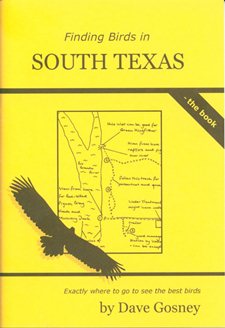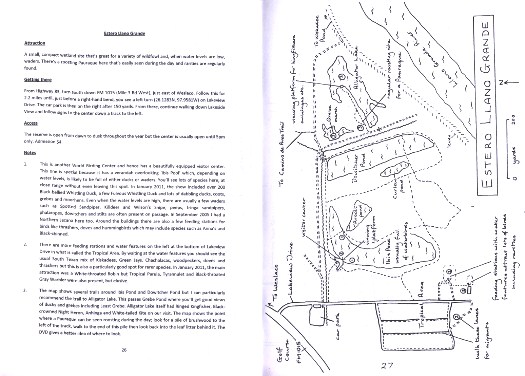Reviewed by Grant McCreary on May 7th, 2014.
The experience of traveling somewhere new for birding has changed drastically even in the ten years that I’ve been doing it. You can now find trip reports and site descriptions on the internet for just about anywhere, and eBird can tell you what you’re likely to find there. No longer do you need a DeLorme atlas when a smartphone can tell you where to go. But one thing hasn’t changed – printed birdfinding guides are still incredibly useful, and often essential. I’ve long relied on such guides from the American Birding Association and others for traveling within the United States, and now I’ve found Dave Gosney’s Finding Birds Series for the Western Palearctic (Europe, northern Africa, and parts of the Middle East).
Dave Gosney is a British birding tour leader who has birded extensively in the Western Palearctic and beyond. He’s produced a series of over 25 guides to the best birding locations in this region, from Lapland to Egypt, Portugal to Turkey, plus South Texas, The Gambia, and Goa (India). Additionally, there’s a companion DVD for 15 of these guides. For the purposes of this review, I’ve checked out two of the books and DVDs, one for a location I’m familiar with – South Texas – and one that I’m not – Extremadura, Spain.
The Books
The books cover the best birding sites for each location and give specific directions on finding the “best” birds – the rare or specialty birds that birders especially want to see. For each site, Gosney gives an overview, directions (with GPS coordinates), and access information (hours, fees, etc). He then goes on to describe specific spots in detail. These are often the best locations to see certain birds. I appreciate how specific he gets, like giving the exact fields to check for Mountain Plover in Texas, or exactly where to look for your best shot at Spanish Imperial Eagle.
Each site includes one or more detailed, hand-drawn maps. Some of the writing on the maps can be small and hard to read, but overall the maps are very clear. Each of the numbered spots in the text is shown on the map, often along with helpful annotations like “Rock Sparrow and Orphean Warbler here” or “best feeding station”.
The books in this Finding Birds series are surprisingly small, averaging about 34 pages each. Part of the reason they’re smaller is that other than the site accounts, there’s a one-page introduction and a map of the entire region on the inside-front cover that serves as a table of contents. And that’s it. The introductory material often found in birdfinding guides is nice to have but not vital, so I don’t really miss it here. Another feature I do really miss is a bird list for the area that includes when they are present (usually in the form of bar graphs). But you can now find that information for many locations elsewhere (like eBird), so again, not vital. But one item that I do consider vital is missing – an index. That may not seem like a big deal until you want to find the best locations for a certain bird. So instead of a quick look at the index, you have to skim through the entire book to see if the bird is mentioned.
You also won’t find any illustrations in the books (apart from the maps, of course). Many birdfinding guides include pictures of birds, but while that makes them more attractive, it does not make them any more useful. Photos of the sites, on the other hand, would be very useful, but Gosney has provided an alternative avenue for those, as I’ll describe later.
The small size does have its advantages; it allows them to be more portable and much less expensive. And despite the small size, the Texas guide – the one that I can judge – is very comprehensive. In fact, I found several places I’ll have to check out on my next visit. Still, I think a couple of additional sites – King Ranch and the San Ygnacio/Zapata area (for White-collared Seedeater) – should be included. But they’re outside the area otherwise covered here, and you have to draw the line somewhere.
The only error I noticed was on page six of the Texas guide where a Screech-owl was referred to as a Western, instead of Eastern.
The DVDs
You can read all about an area, but nothing gives you a feel for the place like seeing it for yourself. So Gosney has produced a companion DVD to go along with 15 (so far) of his guide books (purchased separately). In these 79-minute, on average, videos, Gosney takes us to most of the sites mentioned in the corresponding book. We get to see the area and, more importantly, its birds. Shot on a high-definition camera, the footage looks great. Whether it’s a Green Jay at a feeder or a Lesser Kestrel atop a bull-fighting ring, it makes you want to go and see the bird for yourself.
Gosney is a good host, describing the sites and birds in an informal, and at times funny, manner. You can tell that the video was shot by a birder for birders. Gosney periodically pauses the video or switches to slow motion so that field marks can be better discerned. He also verbally identifies every bird shown. That may seem like an obvious thing to do, but I’m constantly annoyed by documentaries that don’t do this.
I felt that the Texas DVD did the region justice, and most of the specialty birds were shown very well. I don’t know if the same can be said for Extremadura, having never been there, but I do know that it made me really want to go there. Raptors, bustards, Bee-eaters…it just looked amazing.
Note: These DVDs are region 2 and PAL format, which may not be compatible with hardware outside of Europe. Make sure that both your disc player and TV can handle this.
The Website and Apps
Of course, printed media has drawbacks. To mitigate these, there’s a companion website and mobile app. The website – findingbirds.com – includes things that couldn’t be put in the books, like pictures of the sites from nine of the locations, as well as 11 extra maps.
The biggest disadvantage to printed birdfinding guides is that they go out of date. Gosney combats this by posting updates online and on a mobile app. The Finding Birds app – available for Apple, Android, and other devices – allows users to post information for any of the sites in any of the books. This can be sightings, of course, but also information on access. For instance, if you’re in Extremadura it might be helpful to know that as of late April, 2014 one of the productive roads mentioned in the book is closed. Although this app depends on user input to be useful, I was surprised by how many updates there were. The app is free, so I’d highly recommend it as a supplement to any of these guides. You can also find these updates on the Easybirder Facebook page.
Recommendation
Dave Gosney’s Finding Birds guides were written primarily for British birders traveling elsewhere in the Western Palearctic (which is probably why the series doesn’t include anywhere in the UK). But I would highly recommend them to any birder visiting one of these locations. The DVDs are also very useful, serving a double purpose. For those planning a trip they can be used to familiarize yourself with the area. They can also help you figure out where to go. Trying to decide if you should go to The Gambia? Get the video and see if it interests you. My wife’s been trying to get us to go to Spain. You can bet that when we finally do, I’ll have some of these guides with me.
Disclosure: I get a small commission for purchases made through links in this post.
Disclosure: The item reviewed here was a complementary review copy provided by the author. But the opinion expressed here is my own, it has not been influenced in any way.






Comment